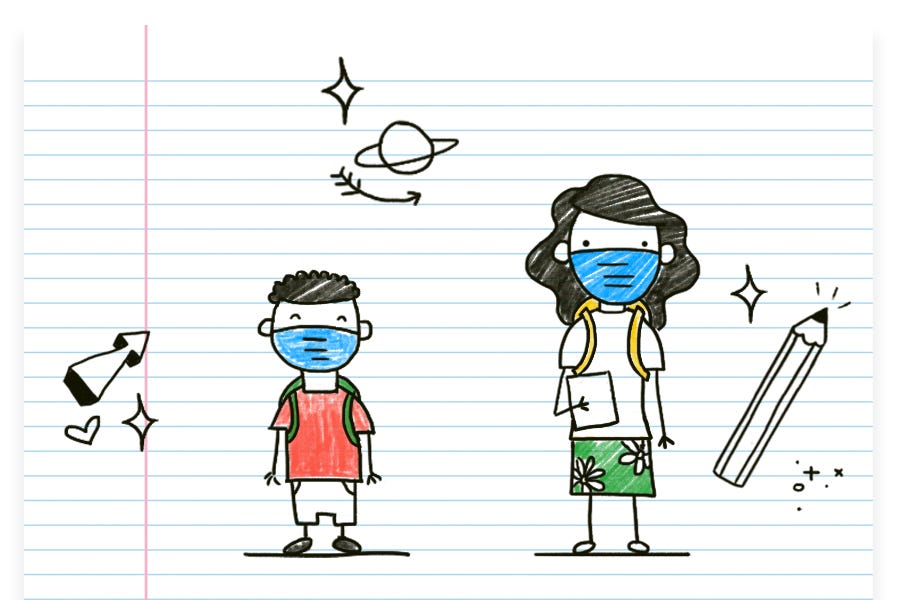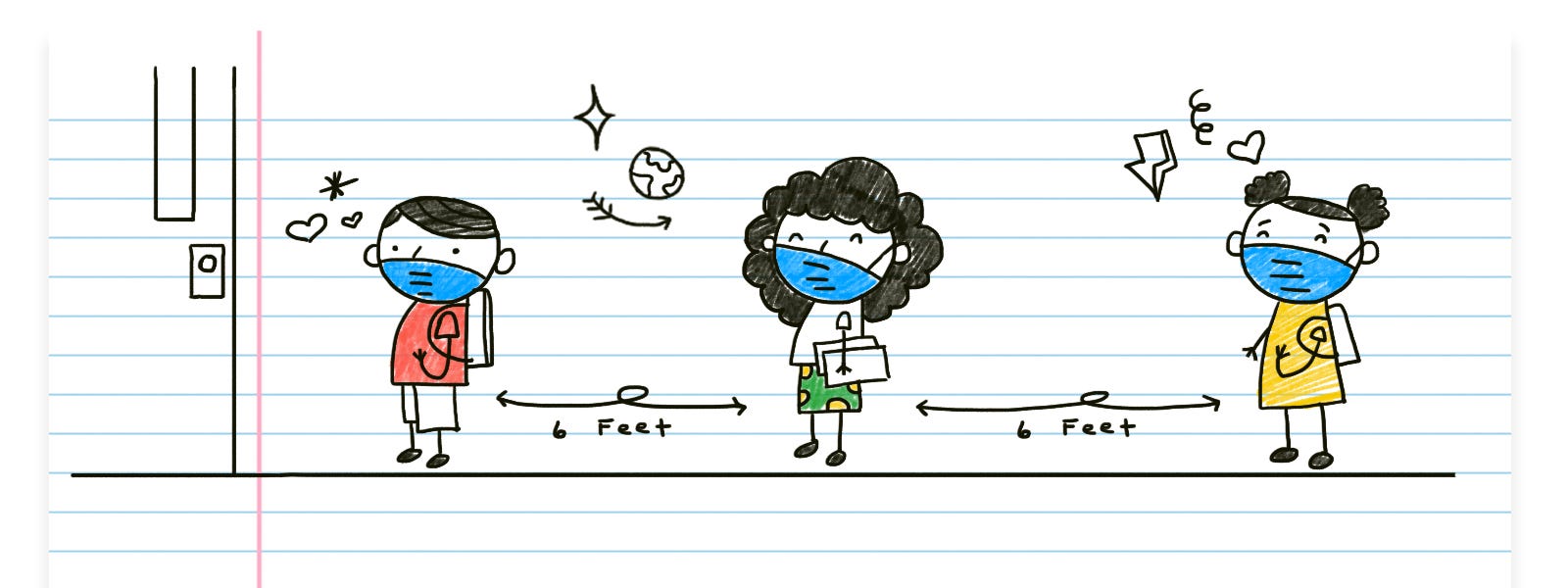We are a few weeks away from back-to-school season, and debate around school reopening is intensifying. Meanwhile, the science around children and COVID-19 is still evolving. One thing is clear: the decision-making process will be unique for each district, school, and family. Here, we answer some of the most pressing questions:
Can children catch COVID-19?
Yes, but they are less likely than adults. A study published in Science has shown that children under age 14 are between one-third and one-half as likely as adults to contract the virus. Another group of researchers looked at 2,000 children and teachers in schools around the German state of Saxony. Tests were carried out in several schools after reopening where there had been known outbreaks of the virus. There were few coronavirus antibodies among children and teachers indicating that only some of them had gotten the disease.
Around 7% of confirmed COVID-19 cases in the U.S. have been among children younger than 18, according to the Centers for Disease Control and Prevention. However, older Americans now represent a lower percentage of infections than they did at the start of the outbreak. Most schools around the country closed in March as the virus began to circulate more widely. That could explain why fewer children got sick.
What happens to kids when they get coronavirus?
Severe impact from COVID-19 is rare for children – most recover within one to two weeks.
"We tested over 8,000 children and the vast majority of these children are having mild symptoms," said Roberta DeBiasi, the chief of pediatric infectious diseases at Children's National Hospital in Washington, D.C.
People less than 18 years old are less likely to have severe disease including shortness of breath. Some children have developed a multisystem inflammatory disorder, dubbed MIS-C. It is a condition where different body parts become inflamed, including the heart, lungs, kidneys, brain, skin, eyes, or gastrointestinal organs.
However, this complication is also rare. In addition, there are only 36 deaths among children under age 14 or 0.03% of total patients who died from COVID-19 nationwide, as of July 22.
Researchers don't know why children seem to be doing better than adults. There are a couple of theories around.
One of them is that children might have a decreased number of the receptors that the virus requires to enter the cells of the body and then grow in those cells.
A child's immune system is designed to sense and respond to new potential threats. It could be better prepared and fit to react to the novel coronavirus than an adult's. With aging, malnutrition, immunosuppression, and long-term diseases, the immune system loses the ability to adapt to novelty.
However, if a person gets the coronavirus, there is no guarantee that the disease won't return.
"If we take the percentage of patients that actually have measurable antibody in their blood, we don't know yet for sure if that antibody, even if it's present at the time that we can detect it, if that is also the type of antibody that will completely protect you from a future infection, " DeBiasi said.
There are also a couple of studies that show coronavirus antibodies may disappear after mere months in some people.
Will coronavirus spread in classrooms?
The virus that causes COVID-19 is primarily spread by respiratory droplets and recent evidence suggests that in some cases, people can become infected with COVID-19 through aerosol transmission.
American classrooms are typically crowded with a few dozen children who, without social distancing and mask-wearing, could spread respiratory droplets to those around them and breathe in those droplets. Students are usually in classrooms for extended periods of time, plenty to facilitate exposure to virus-carrying droplets in the air. And older students often mix with dozens of new students in different classes throughout the day. That’s why a main recommendation from the CDC in reopening schools is to have students of all ages and abilities wear masks and to keep them at least six feet apart as often as possible. The CDC also recommends that schools consider keeping students in cohorts, so that they take as many classes as possible with the same group.
It is also possible to get the virus if you touch your eyes, nose, or mouth after coming into contact with a contaminated surface. Students share toys, remotes, computers, restrooms, chairs, and travel in tight hallways, so schools may indeed facilitate the spread of the disease.
Do children transmit COVID-19?
Yes. A study from South Korea has found that children younger than 10 transmit the novel coronavirus to others much less often than adults do, but the risk is not zero. And those between the ages of 10 and 19 can spread the virus at least as well as adults do.
Researchers studying family clusters in several countries found that children were not likely to be patient zero in their households, only being responsible for around 10% of clusters. In one example, a child with COVID-19 came into contact with more than a hundred children at a ski resort but none got sick.

However, children are also less likely than adults to show symptoms, so the studies may have underestimated the number of children who set off the chain of transmission within their households.
"If children are talking or laughing, or singing or shouting, or sneezing or coughing, and no one thinks that they're infected, but in fact they are, that could be a way to further the spread of the virus out into the population," said Steven L. Zeichner, a professor of pediatrics and microbiology at the University of Virginia.
Other studies have also suggested that the large number of contacts for schoolchildren, who interact with dozens of others for a good part of the day, may cancel out their smaller risk of infecting others.
What about COVID-19 and teachers?
The average age of teachers in U.S. schools is nearly 43. Older teachers tend to work at smaller public and private schools, according to the research by the National Center for Education Statistics. The elderly are at elevated risk for severe illness and death from COVID-19.
What are the plans to reopen schools?
While schools in the U.S. are not yet in session, we have seen some international examples. Some schools have closed temporarily if just one student was diagnosed with COVID-19. Others have stayed open even when multiple children or staff got the disease, sending only affected and direct contacts into quarantine. Some schools also started requiring masks and implemented social distancing measures. Please check with your local school district for specific guidance.
Reopening will require more work for parents and schools. Kids will need to wear a mask, wash hands often, and cover coughs and sneezes with a tissue, as recommended by CDC.
Schools that open will need to implement additional cleaning and disinfection procedures, particularly for hallways, playgrounds, cafeterias and shared workspaces, like libraries. By estimates, the average school district will spend an additional $1.8 million on health and safety measures to reopen.
There are various safety strategies being practiced at schools around the world, which includes combinations of requiring masks, reducing the number of students per classroom, temperature checks, social distancing, and increased hand-washing. Some countries have limited in-person classes to younger students who seem to be at lower risk of contracting and spreading COVID-19.

Recent studies of COVID-19 predict that school closures alone would prevent only 2% to 4% of deaths, much less than other social distancing interventions. A preprint study focusing on five-day closure of nearly all schools in the Seattle metropolitan area estimated that the school closure resulted in a reduction of just a little over 5% in coronavirus infections.
Can social isolation harm my kids?
Continued closures risk “scarring the life chances of a generation of young people,” according to an open letter published last month and signed by more than 1500 members of the United Kingdom’s Royal College of Paediatrics and Child Health (RCPCH). American Academy of Pediatrics (AAP) has advocated for “having students physically present in school” as well.
Social isolation may bring a range of psychological harms. In one study published in JAMA Pediatrics, researchers in Hubei province in China, the origin of the pandemic, examined a sample group of 2,330 schoolchildren for signs of emotional distress. The kids had been locked down for an average of 33.7 days. Even after that single month, 22.6% of them reported depressive symptoms and nearly 19% were experiencing anxiety.
Children who already suffer from depression and anxiety may be at a higher risk. In the aftermath of 9/11, adolescents’ level of distress closely tracked whether or not they had a history of such conditions.
Should schools stay closed?
There is no one-size-fits-all approach when it comes to the question of whether the schools should be opened or closed. Experts continue to say schools should make that decision primarily on whether COVID-19 is spreading in their region. In much of the country, coronavirus is spiking right now.
"Each particular school, district or county has to look with their health department at what the daily increase in cases is, or the seven day average of increases in cases and get a handle on whether or not the virus is in control in their region or their county or not," DeBiasi said.
Next, schools should consider whether they might be able to implement safety measures, like maintaining social distance, and decreasing class sizes. The third level is individual families.
"In a family that has many elderly people living in a household, or has immunocompromised parents or other children in the household, the decision for that family to send their child into a school in person may be completely different than a household where there are no elderly people," DeBiasi said.
Some of the kids may also be more vulnerable than others. The children and young adults over 15 years of age were more likely to require critical care in a study led by DeBiasi. She and her colleagues examined the medical records of symptomatic children and young adults who sought treatment at Children’s National for COVID-19 between March 15 and April 30. The majority of children hospitalized had an underlying condition.
Young patients with underlying neurological conditions, such as cerebral palsy, microcephaly, or global developmental delay were significantly more likely to require hospitalization. Other common underlying diseases included congenital heart disease, cancer and blood disorders. Immunosuppressed patients and the ones with a disease that would cause them to potentially have trouble breathing may also be in greater danger.